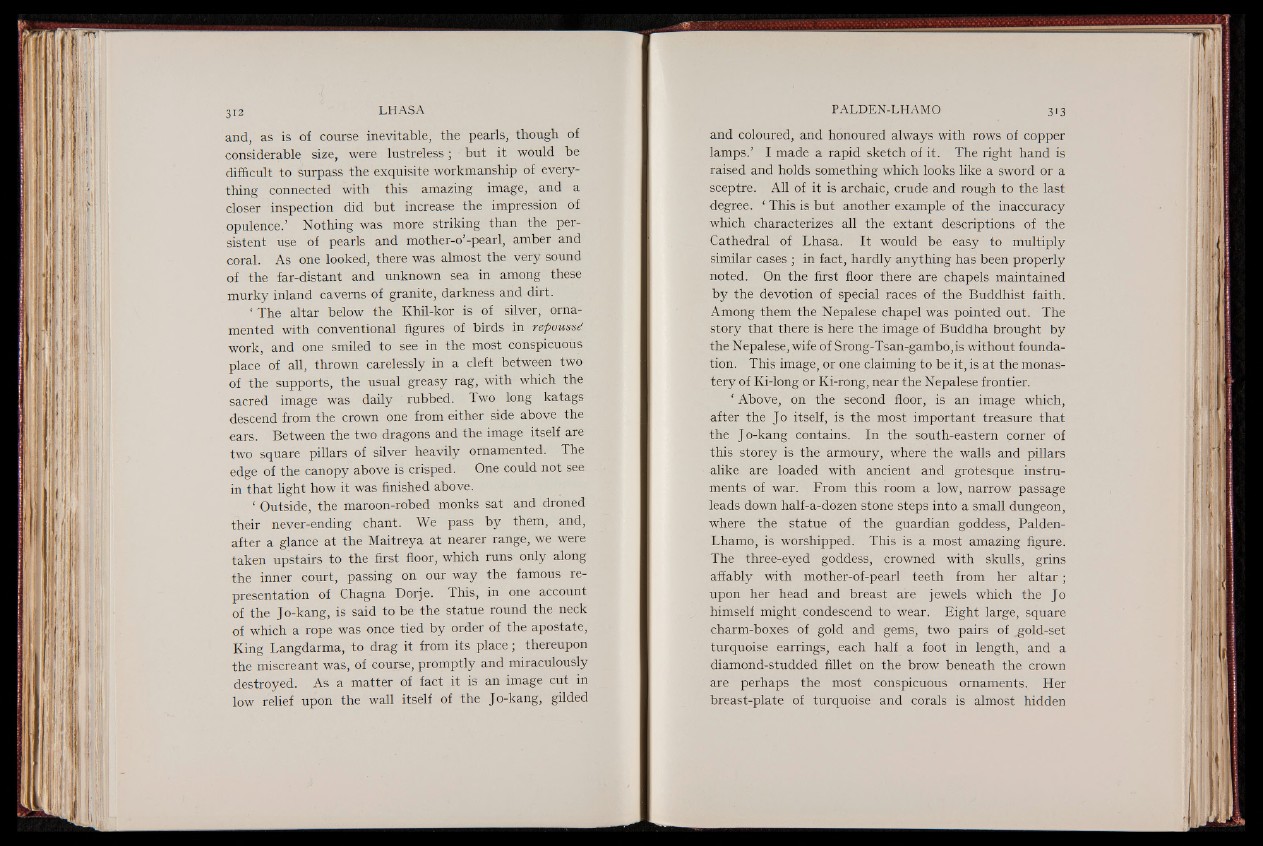
and, as is of course inevitable, the pearls, though of
considerable size, were lustreless ; but it would be
difficult to surpass the exquisite workmanship of everything
connected with this amazing image, and a
closer inspection did but increase the impression of
opulence.’ Nothing was more striking than the persistent
use of pearls and mother-o’-pearl, amber and
coral. As one looked, there was almost the very sound
of the far-distant and unknown sea in among these
murky inland caverns of granite, darkness and dirt.
‘ The altar below the Khil-kor is of silver, ornamented
with conventional figures of birds in repoussé
work, and one smiled to see in the most conspicuous
place of all, thrown carelessly in a cleft between two
of the supports, the usual greasy rag, with which the
sacred image was daily rubbed. Two long katags
descend from the crown one from either side above the
ears. Between the two dragons and the image itself are
two square pillars of silver heavily ornamented. The
edge of the canopy above is crisped. One could not see.
in that light how it was finished above.
‘ Outside, the maroon-robed monks sat and droned
their never-ending chant. We pass by them, and,
after a glance at the Maitreya at nearer range, we were
taken upstairs to the first floor, which runs only along
the inner court, passing on our way the famous representation
of Chagna Dorje. This, in one account
of the Jo-kang, is said to be the statue round the neck
of which a rope was once tied by order of the apostate,
King Langdarma, to drag it from its place ; thereupon
the miscreant was, of course, promptly and miraculously
destroyed. As a matter of fact it is an image cut in
low relief upon the wall itself of the Jo-kang, gilded
and coloured, and honoured always with rows of copper
lamps.’ I made a rapid sketch of it. The right hand is
raised and holds something which looks like a sword or a
sceptre. All of it is archaic, crude and rough to the last
degree. ‘ This is but another example of the inaccuracy
which characterizes all the extant descriptions of the
Cathedral of Lhasa. It would be easy to multiply
similar cases ; in fact, hardly anything has been properly
noted. On the first floor there are chapels maintained
by the devotion of special races of the Buddhist faith.
Among them the Nepalese chapel was pointed out. The
story that there is here the image of Buddha brought by
the Nepalese, wife of Srong-Tsan-gambo,is without foundation.
This image, or one claiming to be it, is at the monastery
of Ki-long or Ki-rong, near the Nepalese frontier.
‘ Above, on the second floor, is an image which,
after the Jo itself, is the most important treasure that
the Jo-kang contains. In the south-eastern corner of
this storey is the armoury, where the walls and pillars
alike are loaded with ancient and grotesque instruments
of war. From this room a low, narrow passage
leads down half-a-dozen stone steps into a small dungeon,
where the statue of the guardian goddess, Palden-
Lhamo, is worshipped. This is a most amazing figure.
The three-eyed goddess, crowned with skulls, grins
affably with mother-of-pearl teeth from her a lta r ;
upon her head and breast are jewels which the Jo
himself might condescend to wear. Eight large, square
charm-boxes of gold and gems, two pairs of ,gold-set
turquoise earrings, each half a foot in length, and a
diamond-studded fillet on the brow beneath the crown
are perhaps the most conspicuous ornaments. Her
breast-plate of turquoise and corals is almost hidden